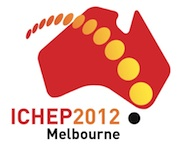Speaker
Dr
Satish Desai
(Fermilab)
Description
We present searches for a low mass standard model Higgs boson produced in association with a W or a Z boson at a center of mass energy sqrt(s)=1.96 TeV with the D0 detector at the Fermilab Tevatron collider. The search is performed iin the full D0 Run2 data sample using the leptonic decay channels of the W and the Z boson (W--->lv, Z--->ll and Z--->vv) leading to signatures with one lepton and an imbalance in the transverse energy, or two leptons, or just a large imbalance in the transverse energy, in association with one or two b-tagged jets.
We present a search for a low mass Standard Model Higgs boson produced in association with a Z boson decaying invisibly into a pair of neutrinos at a center-of-mass energy of sqrt(s)=1.96 TeV with the D0 detector at the Fermilab Tevatron collider. A significant signal contribution also arises from associated WH production with a leptonic W boson decay in which the charged lepton is not identified. The search is performed in events containing a large imbalance in the transverse energy, and one or two b-tagged jets and uses the full D0 Run 2 dataset. This channel is one of the most powerful ones in the search for a low mass Higgs boson at the Tevatron, but it is experimentally challenging due to the large QCD backgrounds and absence of visible leptons in the final state.
We present a search for a low mass Standard Model Higgs boson produced in association with a Z boson decaying to charged leptons at a center-of-mass energy of sqrt(s)=1.96 TeV with the D0 detector at the Fermilab Tevatron collider. The search is performed in events containing two opposite-sign leptons (electron or muon) and one or two b-tagged jets and uses the full D0 Run 2 dataset. The reconstruction of a leptonic Z boson and the fully constrained kinematics provide powerful experimental handles to both suppress backgrounds and improve the dijet mass reconstruction, making this a very important channel in the search for a low mass Higgs boson at the Tevatron.
Author
Dr
Satish Desai
(Fermilab)
